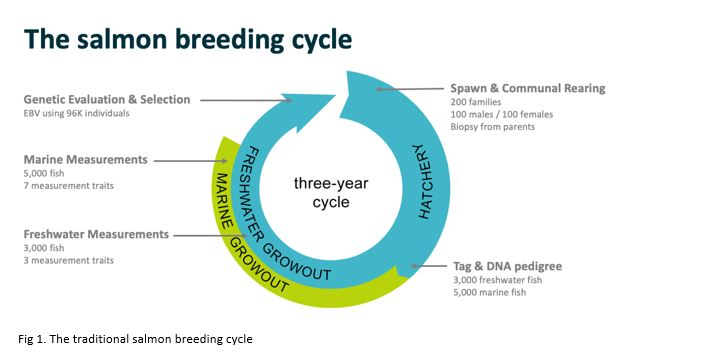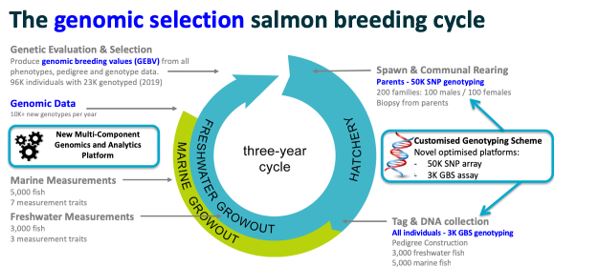The challenge
Tasmanian Atlantic salmon grow faster but at a cost

Most of the Australian salmon farming is in Tasmania, where waters are amongst the warmest in the world for Atlantic salmon culture. These warm temperatures mean that Tasmanian Atlantic salmon can grow to a harvestable size significantly faster than in other farmed areas. However, faster growth comes at a cost: early sexual maturation can affect product availability and quality, and temperature related susceptibility to disease, notably amoebic gill disease (AGD), which can result in significant stock losses. Consequently, harvest weight, AGD disease resistance and maturation incidence were important traits to select within the breeding programme.
Substantial gains were made in the breeding programme through traditional selection approaches for these key traits. However, such approaches successfully ranked families for performance but were unable to facilitate the best selection of individuals within families. This is due to the structure of the breeding cycle and results in a loss of efficiency. Genomics selection was identified as a potential solution. Genomics refers to the complete set of genes in a cell or organism. The challenge was to design and implement a genomic selection strategy with the essential genotyping platforms that could be seamlessly integrated into the salmon breeding cycle and could deliver maximum gains to the programme.
Infographic demonstrates the traditional salmon breeding cycle. It shows the measurements taken and the results in a three-year cycle in a circular direction anticlockwise from: 
Our response
A platform to enable the implementation of genomic selection
Infographic showing the genomic selection salmon breeding cycle. Blue text (italicised) indicates the new components of the original breeding cycle and the cyan boxes (bolded) contain the essential components developed to enable the commercial implementation of genomic selection. 
Novel optimised platforms:
In a joint project with Salmon Enterprises of Tasmania Pty Ltd (SALTAS), CSIRO designed and implemented a cutting-edge genomics and analytics platform to enable the implementation of genomic selection. The platform included multiple components linked via a seamless workflow, including genomic data cleaning and imputation, data manipulation, complex statistical modelling and output post-processing.
Essential to genomic selection is appropriate genomic tools, two custom genomics tools were designed and created using optimisation strategies to allow for cost-effective and efficient geno-typing of the maximum number of fish within the selective breeding programme. Due to rapid and successful platform development, genomic selection was implemented for all production traits for the first time in 2016, a single year after the programme began in 2015, with full deployment achieved in 2018.
The results
The results of genomic selection
Genomic selection has been demonstrated to increase rates of gain in the SALTAS breeding programme. The annual rate of gain for AGD resistance has increased from 4 per cent to 6 per cent per year with significant gains also being achieved in all other traits (harvest weight, maturation incidence and flesh colour).
This project showcases the high impact of, and major return from, CSIRO's innovative science capability and nationally important industries.
Substantial economic impact is expected to continue through production efficiencies and productivity gains. The genomic selection platform is enabling selection in previously unselected commercial populations that will transform commercial production producing even greater genetic and economic gains. The platform continues to evolve, expanding to tackle new traits important to the industry, including summer growth.
